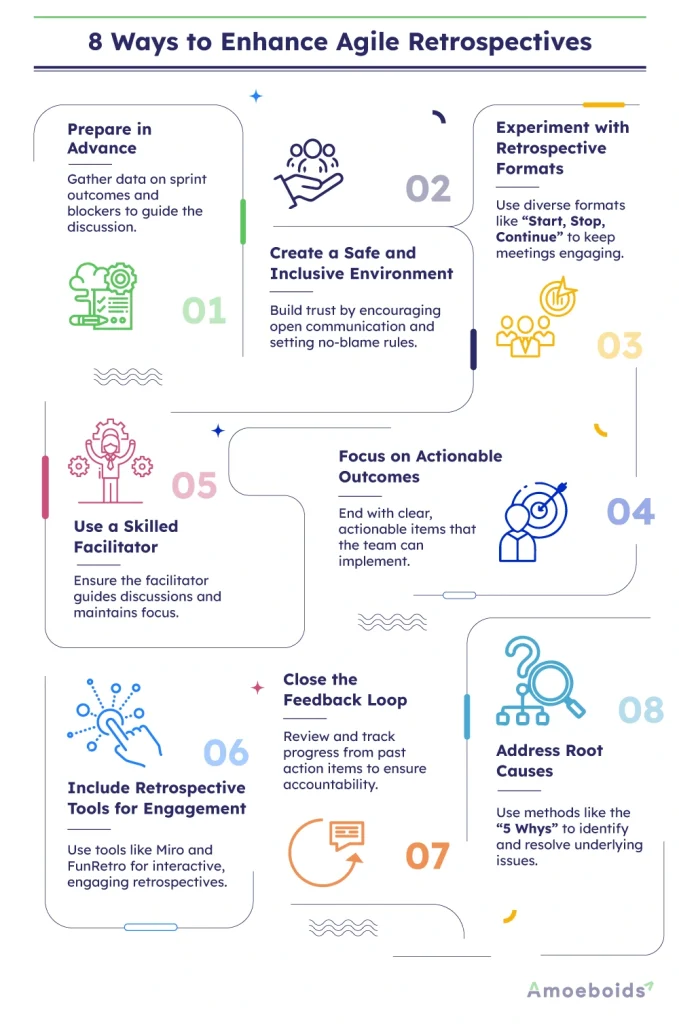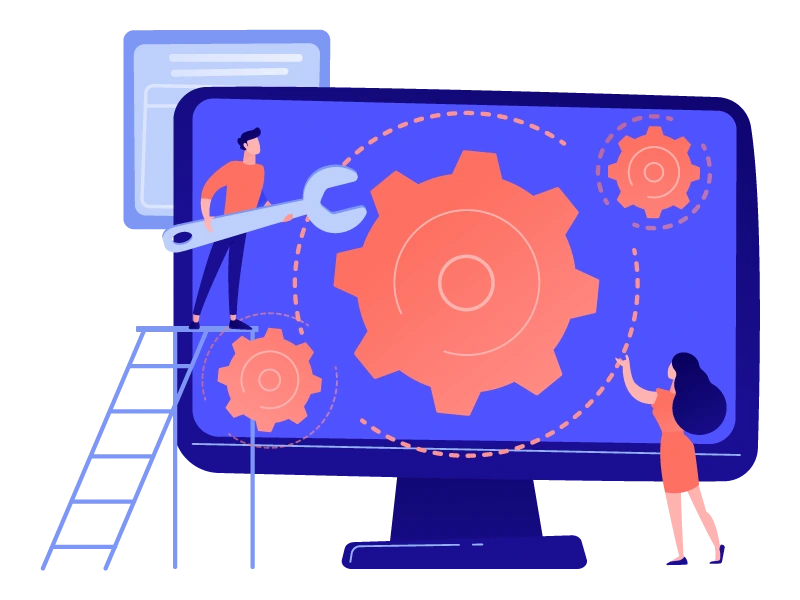Your team has just finalized a detailed project plan. The goals are clear, the timelines are set, and yet, a few weeks in, deadlines are slipping. What went wrong? The only way to find out is to sit with your team and listen to their challenges. That’s where agile retrospectives come in.
Agile retrospectives are at the heart of high-performing teams, but their success depends on how you use them. These sessions focus on reflecting on past sprints to identify challenges and improve future performance. When executed correctly, they can turn struggling teams into best performers. But what’s the secret recipe?
This blog will explore common challenges teams face during agile retrospectives and share practical tips for overcoming them. You’ll also learn the best practices for making your sessions truly impactful.
Why do agile retrospectives matter?
Agile retrospectives are more than team meetings–They allow teams to pause, reflect, and reset. There are four important reasons why these agile meetings hold immense importance for all teams:

Continuous team improvement
These meetings support continuous team improvement. For example, if a deadline was missed because tasks weren’t prioritized, the team can refine how they plan the next sprint.
Enhanced team collaboration
These sessions bring everyone together and build accountability. For instance, when a developer explains a delay, the whole team feels responsible for finding a solution together.
Fosters open communication
Bringing everyone together to communicate their challenges and weaknesses openly creates a space for open communication and collective problem-solving. Imagine a team member sharing they felt overwhelmed!
Promotes feedback
It encourages feedback from the team to promote agility in future processes and decision-making. For example, a designer might suggest a faster review process after facing delays during approvals.
Even with these benefits, retrospectives sometimes need to catch up. Teams must recognize the reasons behind these failures to maximize their sessions.
Common challenges in agile retrospectives
Imagine this scenario. Your team gathers for an agile retrospective after a sprint. The facilitator asks, “What could we improve?” and is met with silence. A few hesitant comments trickle in, but they’re vague. Some team members look disengaged, while others seem uncomfortable speaking up. You end the session feeling like nothing meaningful was achieved. Sound familiar?
Agile retrospectives can face several similar hurdles that make them less effective. Let’s explore the most common challenges and why they happen, with simple examples:
Lack of participation
Retrospectives lose value when team members don’t share openly. For example, a junior developer might avoid speaking up, fearing their feedback could upset a senior.
Redundancy over time
Sometimes, your team members may lack enthusiasm for communicating in retrospect simply because there are too many such agile meetings. For example, if every meeting revolves around delays, the members might begin to disengage.
Superficial discussions
Teams often address symptoms, ignoring the underlying root causes. For instance, they say, “We underestimated the timeline,” but the real problem was a miscommunication between developers and testers.
Fault-finding mindset
Blame games derail retrospectives. For example, sometimes retrospectives about missed deadlines turn into a blame session instead of devising a way to fix it.
Poor facilitation
Disorganized discussions only waste the team’s time and leave everyone without a conclusive plan. For example, think of a meeting where everyone talks over each other, and no clear action plan emerges.
Overcoming these challenges is important for teams to make the most of these meetings. But that’s where the real challenge lies. Let’s look at some practical tips to help you & your team get more out of these sessions.
8 tips to improve agile retrospectives
Here are some proven ways to help make your sessions more engaging and impactful. Even small changes can inspire big improvements.

1. Prepare in advance
Preparation begins long before the agile retrospective session starts. It is imperative to gather data on the sprint outcomes, such as velocity trends, recurring blockers, and various successes, beforehand.
For example, create a simple chart showing recurring delays in Jira or Trello. This will give the team a clear starting point and keep the discussion focused.
2. Create a safe and inclusive environment
Encourage conversations by setting ground rules for a safe and inclusive environment. For instance, agree on “no blaming” and focus on solutions instead.
The aim is to make everyone, even quieter team members, feel comfortable sharing their thoughts. Under such settings, you might be surprised to see your junior developer contributing great ideas when they feel safe to speak.
3. Experiment with retrospective formats
Keep things fresh with varied formats. For instance, Try the “Start, Stop, and Continue” method: What should the team start doing? Stop doing it? Keep doing it? These formats add variety and provide a clear direction to the meeting.
4. Use a skilled facilitator
How conversations in the meeting are facilitated can make all the difference. For instance, the facilitator role should be kept rotating to build confidence across the team. If a team member leads for the first time, they’ll gain skills and encourage others to speak up.
5. Focus on actionable outcomes
To make the retrospective beneficial, it is crucial to walk away from it with a list of to-do’s. You must turn team feedback into actionable goals.
For example, set tasks like “reduce code review time by 24 hours” or “resolve critical bugs in 48 hours.” You can then assign these targets to team members and set deadlines for follow-up.
6. Include retrospective tools for engagement
You can use retrospective tools such as Miro, Confluence, or FunRetro to facilitate smoother retrospectives for remote and hybrid teams. In addition, you can break the ice by using interactive elements. You can add elements like polls, thumbs up/down voting, mood meters, etc. For instance, a quick survey on blockers can reveal patterns without lengthy explanations.
7. Close the feedback loop
To close the feedback loop, tracking the progress made since your last retrospective is essential. Reviewing these developments not only highlights achievements but also fosters accountability within the team.
Celebrate the improvements, no matter how minor they seem. This recognition motivates your team and reinforces their efforts. Following through on past feedback and action items ensures that each retrospective drives growth and improvement.
8. Address root causes
For recurring issues, it is crucial to conduct a root cause analysis. You can use the 5 whys method to assess the cause-effect relationship of recurring problems. Besides this, you can also use the fishbone diagram to dig deeper to study the potential causes of a deeper problem.
These tips are just the beginning. Agile retrospectives evolve with your team’s needs, so always look for new ideas and approaches. But how do you know if your retrospectives are truly effective? Tracking the right metrics can give you valuable insights.
Let’s explore some common metrics to track the success of your agile retrospectives.
Common metrics to track agile retrospective effectiveness
It is extremely important to evaluate the effectiveness of your retrospectives constantly. However, tracking the most relevant metric is crucial to create an impact. Consider evaluating these four metrics to identify what’s working and what’s not:
1. Participation rate
Participation rate shows how actively the team members contribute during agile retrospectives. If the participation rate is low, it hints at a lack of psychological safety. For example, if only half the team speaks up, it’s a sign that you need to create a more inclusive environment. Then it is the responsibility of the scrum master to address this problem.
2. Action item completion rate
This metric determines whether the agreed-upon action items from retrospectives are being implemented. This metric highlights the team’s accountability and commitment to improvement. For instance, if the team decided to improve code review turnaround but nothing changed, it’s time to check why the follow-through isn’t happening.
3. Repetition of issues
This metric tracks repeated issues to assess whether the problems highlighted in retrospectives are being resolved. Using this metric, you can track whether any unresolved issues may indicate deeper inefficiencies in processes. For example, recurring testing delays might indicate deeper process issues that need immediate attention.
4. Team feedback
Most importantly, team feedback is the most significant measure of retrospective effectiveness. This feedback can be utilized to make tailored adjustments. Regularly ask your team how retrospectives can be improved through surveys. For instance, a simple poll might reveal that shorter sessions work better for your team.
You can improve your agile retrospectives with metrics and drive meaningful changes. But what does a truly effective retrospective look like? Let’s look at some examples of great practices to inspire your team and take your retrospectives to the next level.
Examples of great agile retrospective practices
Agile retrospectives shine when they lead to actionable changes. Let’s look at two practical examples where retrospectives made a real difference:
Example 1: How a team reduced deployment time by improving communication through retrospectives
A development team faced prolonged deployment times caused by misaligned priorities between developers and testers. During retrospectives, they uncovered that the root cause was the lack of structured communication and clear handoffs.
To address this, the team implemented daily sync-ups to align priorities, established centralized documentation for deployment tasks, and clearly defined responsibilities for each deployment stage. These changes reduced deployment time by 30%, creating a smoother and faster workflow.
Example 2: A team increased sprint velocity by identifying and eliminating specific blockers
A team experienced repeated delays in sprint completion due to unclear task requirements. Retrospectives revealed that poorly defined user stories were the primary issue.
In response, the team revamped its sprint planning process by regularly conducting backlog refinement sessions. This improvement eliminated blockers and boosted sprint velocity by 25%, enabling the team to meet deadlines consistently.
Conclusion
See how powerful retrospectives can be? They’re not just meetings but opportunities to learn, grow, and fix what’s broken. They can provide fresh insights into what you are doing right and what you aren’t. And if you take retrospectives seriously, you can identify problems, find solutions, and keep your team at the top of their capacity.
But here’s the catch—retrospectives only work if you keep them fresh and meaningful. So, don’t let them become just another routine. Shake things up, make them engaging, and keep adapting to your team’s needs.
After all, the best retrospectives are the ones that grow with you.



